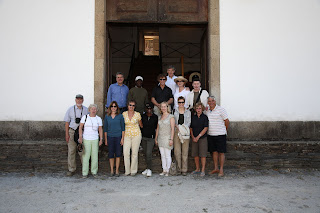The ride from the train station to our weekend home is a short 300 meters. The vineyard stretches away in all its majesty up and out to our left and front. The road from the train station merges into the road leading down from the vineyard to make its way under the train track. A left turn brings us face to face with our home: the estate house.
The house is a white, three-storied, 19th-century structure that is separated from the river by a feeder road and with a longitudinal portion running east to west and a chapel attached to its western end. It is endowed with 40 rooms and there is a large, open-air veranda running the length of the building which is memorable for the many special meals, aperitifs, and digestifs consumed therein by our team. The building's size is hidden by the way in which it is presented to the viewer and its interior is quaintly furnished. Bathrooms are ex-suite.
At dinner on Friday evening, Paul had promised us that we would be awakened at 6:00 am by the winery foreman dropping a gear as he made the turn by the house on his way to the adega. So said, so done. And it was loud in the piercing silence that is a part of this vast, underpopulated expanse. So we tumbled out of bed, conducted our ablutions, and congregated on the veranda for a much-anticipated breakfast.
After breakfast we piled into vehicles driven by Paul and the viticulturist and drove up a steep, winding road which took us into the upper reaches of the estate. It was awe-inspiring. The view across the expanse of the estate and the estate across the river was breathtaking. Then the vehicles stopped. Paul jumped out, ducked under the vine wire and stepped out onto a narrow ledge (his wife drew her breath in sharply and refused to look further), and beckoned us to form a semi-circle around him. He then began to tell us the story of Quinta do Vesuvio.
He reached down (oohs and aahs) and came back up with some rock fragments in his hand. The soil, he explained, was schist, a metamorphic rock with a high mineral content, with some granite outcroppings. As is the case for all soil above the Valeria gorge, the soil at Quinta do Vesuvio is alkaline (the soil below the gorge is acidic). The specific vineyard in which we were congregated was called the Schoolhouse vineyard because a school for the vineyard workers had been located in this part of the estate. The entire Quinta do Vesuvio estate is is 340 hectares, with 146 planted to vine, and is 3 kilometers from end to end.
The property is subjected to temperature extremes during the course of the year. Winters are freezing cold and fog will sometimes come into the valley and block out sunlight for periods of up to two weeks. Summers, on the other hand, are very hot with temperatures getting as high as 50 degrees C (122 degrees F). Rainfall averages a low 400 mm per year.
The slopes are primarily north-facing, allowing the grapes to benefit from the luminosity of the sun without having to deal with the long, direct sunlight (in Douro heat) associated with south-facing slopes. Elevation ranges from 180 meters at the waterline to 530 meters in the upper reaches of the estate. Vines are trained single Guyot on hillside terraces with two rows of vines per terrace. The Symingtons have been extremely agressive in their stewardship of the estate. Between 1990 and 1991, they planted 61,500 vines and added 30 hectares (90,00 vines) of Touriga Nacional vineyards in pretty inhospitable terrain in 2003. Terracing at Vesuvio is of the patamares (banked earthen walls) variety.
There are approximately 375,000 vines planted at Vesuvio: 33.8% Touriga Nacional; 19.6% Tinta Barroca; 18.5% Touriga Franca; 17.8% Tinta Roriz; 3% Tinto Amaral; 1.6% Sousao, .3% Tinta Cao; and 5% other. The average age of the newest vines is 10 years while the older vines average 35 years.
Two treatments of fertilizers are conducted during the course of the year. There is also spraying to prevent against odium and mildew. "If you do not pay constant attention to your vines you can lose them," says Paul.
Grapes are hand harvested with first-level selection in the field. Teams of pickers are brought in from far-away villages and are housed on the property for the duration of harvest. Grapes are placed into bright blue containers which are stacked onto tractors and trucked down to the winery for immediate crushing.
My next post will discuss operations within the adega.


















No comments:
Post a Comment